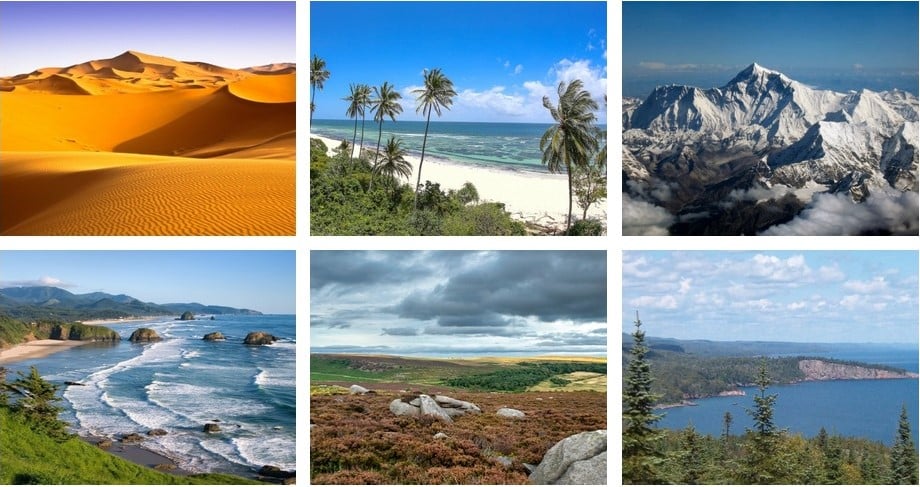A picture is worth a thousand words, which is why photos uniquely tell stories. From the beginning of time, man has sought ways to preserve precious memories and has used different methods, from stone engravings to drawings. With the invention of cameras, photos became, and will always be, the best way to preserve memories and express our artistic sides.
Apart from selfies, landscape photos are probably one of the most popular photos taken today. A landscape photo, in technical terms, is any photograph of land, countryside, structures, people, objects, or animals. That means a landscape photo can be any photo you take of your surroundings, whether hiking, walking, or camping in the woods.
Types of Landscape Photos
Understanding the distinction between a landscape and a nature photograph is critical. Landscape photography encompasses all forms of nature stills; therefore, a nature shot falls under that category. However, the scope of a landscape photo is broader than that of nature. There are three main types of landscape photos:

Representational Landscape Photos
A representational landscape photo shows all the qualities and details of the scene without any manipulation. The majority of the time, it is precise as the name says; there is no change. You will see the scene just as it is; even after editing, the changes are typically minor. This type of landscape photography is probably the most common, especially among amateurs. Representational landscape photos are easy to capture and can be seen in various professional portfolios.

Abstract Landscape Photos
An abstract landscape photograph depicts scenes in a way that differs from how you would normally perceive them. It is a diverse yet creative side to landscape photography. For example, the setting sun is a common subject in landscape photography. But, if you happen to photograph it on the rippling ocean or just as the waves rise to frame it, you will have something unique though abstract. It changes the photograph’s narrative, giving you a fresher perspective on an old story.

Impressionistic Landscape Photography
Impressionistic landscape photography lies halfway between the abstract type and the recreational type. This type of photo has some manipulations to make the final result more eye-catching than the original shot. Thus, the photo is edited to impress the viewer and elevate the concept of the landscape photo. Such images allow your creative juices to flow without completely obliterating the scene.

4 Important Steps to Capture Flawless Landscape Photos
As mentioned, a landscape photo is easy to capture. But, such shots are also very easy to mess up if one isn’t careful. Thus, if you are going to catch the true essence of the moment like a professional, here are a few steps to help you along the way.

Step 1: Don’t Shake the Camera
Camera shake is the bane of excellent photography. Avoid holding the camera with your hand as much as possible, no matter how steady your hands are. Thus you can use a camera to keep from capturing blurry landscape photos-steadying equipment, like a tripod. Adding a remote shutter release to the package would improve picture quality, with sharp and clear images.
Step 2: Reduce the Camera Aperture
The aperture of a camera is the opening that allows light to get to the camera. It controls the amount of light the camera is exposed to while taking an image. The best landscape photos are shot with an aperture setting of F/8 and F11. It helps you produce sharp and focused images that capture a landscape in all its glory. Thus, if you want a great landscape photo, reduce the aperture to let in less light than usual. That way, the field depth widens, and the image you are capturing becomes the center of the photo.
Step 3: Choose the Right Lighting
Using the correct aperture is only one of the first steps to choosing the proper lighting. You also must consider the time of day you take the photos. While most landscape photos tend to come out great if taken with good cameras, they will even be better with the proper lighting. Typically, the hour after the sun rises, called the ‘Golden Hour,’ gives excellent lighting. The same applies to the hour before the sun goes down. You will get more amazing photos with these lightings than those taken in the middle of the day.
Step 4: Use the Right Horizon Line
A horizon line is a clear boundary you see between the sky and the earth. In other words, it is where the skyline joins the flat ground or sea. It can serve as a direction marker for amateur photographers and help them improve their skills. If you use the lower third as your horizon line or placement in your landscape photos, the photo will be exceptional.
Conclusion
A landscape photo is one of the most original forms of artistic expression. It goes beyond just pictures of beautiful snow-capped mountains and lovely autumn days. No matter how gorgeous they are, the lack of proper interpretation removes the moment’s beauty. Nonetheless, we find ourselves gazing at beautiful landscape photos even when the depiction is common.
Our deep-seated attraction to nature and all it entails draws us to even the most common representation. Your immediate surroundings or a nearby park can become a landscape photo, but its beauty and importance go beyond just taking the picture with a good camera. You must take the proper steps and incorporate your artistic or creative side to create a fantastic shot. Once that is done, you have all the hallmarks of a good artist at hand, ready to take on a world, one camera at a time.
